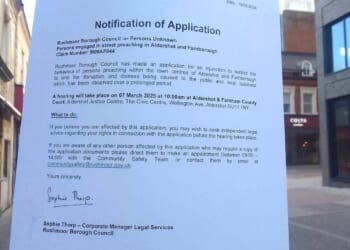
JERUSALEM — An Israeli probe into the killings of 15 Palestinian medics last month in Gaza by Israeli forces said Sunday it has found “professional failures” and a deputy commander will be fired.
Israel at first claimed that the medics’ vehicles did not have emergency signals on when troops opened fire but later backtracked. Cellphone video recovered from one of the medics contradicted Israel’s initial account.
The military investigation found that the deputy battalion commander, “due to poor night visibility,” assessed that the ambulances belonged to Hamas militants. Video footage obtained from the incident shows the ambulances had lights flashing and logos visible as they pulled up to help another ambulance that came under fire earlier. The teams do not appear to be acting unusually or in a threatening manner as three medics emerge and head toward it.
Their vehicles immediately come under a barrage of gunfire that goes on for more than five minutes with brief pauses.
Eight Red Crescent personnel, six Civil Defense workers and a U.N. staffer were killed in the shooting before dawn on March 23 by troops conducting operations in Tel al-Sultan, a district of the southern Gaza city of Rafah. Troops bulldozed over the bodies along with their mangled vehicles, burying them in a mass grave. U.N. and rescue workers were only able to reach the site a week later to dig out the bodies.
The head of the Palestinian Red Crescent Society has said the slain men were “targeted at close range.”
The Israeli military investigation said the Palestinians were killed due to an “operational misunderstanding” by Israeli forces, and that a separate incident 15 minutes later, when Israeli soldiers shot at a Palestinian U.N. vehicle, was a breach of orders.
It was not immediately clear whether the military investigation found that any of those killed were Hamas militants. Israel’s military initially said nine were militants.
The investigation found that the decision to crush the ambulances was wrong but denied that there was an attempt to conceal the event.
“The examination found no evidence to support claims of execution or that any of the deceased were bound before or after the shooting,” it added.
The statement on the findings concluded by saying that Israel’s military “regrets the harm caused to uninvolved civilians.” The one survivor was detained for investigation and remains in custody for further questioning.
The investigation’s findings have been turned over the Military Advocate General, which can decide whether to file charges. It is meant to be an independent body, with oversight by Israel’s attorney general and Supreme Court.
There are no outside investigations of the killings underway.
Israel has accused Hamas of moving and hiding its fighters inside ambulances and emergency vehicles, as well as in hospitals and other civilian infrastructure, arguing that justifies strikes on them. Medical personnel largely deny the accusations.
Israeli strikes have killed more than 150 emergency responders from the Red Crescent and Civil Defense, most of them while on duty, as well as over 1,000 health workers during the war, according to the U.N. The Israeli military rarely investigates such incidents.
Palestinians and international human rights groups have repeatedly accused Israel’s military of failing to properly investigate or whitewashing misconduct by its troops.
The International Criminal Court, established by the international community as a court of last resort, has accused Israeli Prime Minister Benjamin Netanyahu and former defense minister Yoav Gallant of war crimes. Israel, which is not a member of the court, has long asserted that its legal system is capable of investigating the army, and Netanyahu has accused the ICC of antisemitism.
The war in Gaza began when Hamas-led militants attacked southern Israel on Oct. 7, 2023, killing about 1,200 people, mostly civilians, and abducting 251. Most of the hostages have been released in ceasefire agreements or other deals. Hamas currently holds 59 hostages, 24 of them believed to be alive.
Israel’s offensive has since killed over 51,000 Palestinians, mostly women and children, according to Gaza’s Health Ministry, which does not distinguish between civilians and combatants.
The war has destroyed vast parts of Gaza and most of its food production capabilities. Around 90% of the population is displaced, with hundreds of thousands of people living in tent camps and bombed-out buildings.
Frustration has been growing on both sides, with rare public protests against Hamas in Gaza and continued weekly rallies in Israel pressing the government to reach a deal to bring all hostages home.


![NYC Tourist Helicopter Falls into Hudson River, Siemens Executive and Family Among Those Killed [WATCH]](https://www.right2024.com/wp-content/uploads/2025/04/NYC-Tourist-Helicopter-Falls-into-Hudson-River-Siemens-Executive-and-350x250.jpg)






![Red Sox Fan Makes the ‘Catch of the Day’ with Unconventional ‘Glove’ [WATCH]](https://www.right2024.com/wp-content/uploads/2025/04/Red-Sox-Fan-Makes-the-‘Catch-of-the-Day-with-350x250.jpg)
![Green Day’s Cringe Trump Diss Ends in Fire and Evacuation [WATCH]](https://www.right2024.com/wp-content/uploads/2025/04/Green-Days-Cringe-Trump-Diss-Ends-in-Fire-and-Evacuation-350x250.jpg)






